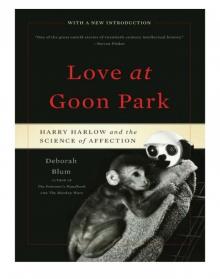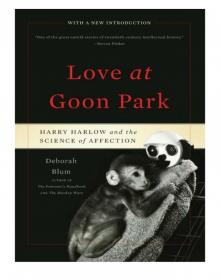- Home
- Deborah Blum
Love at Goon Park: Harry Harlow and the Science of Affection Page 22
Love at Goon Park: Harry Harlow and the Science of Affection Read online
Page 22
The researchers began to suspect that the subdued response of the stay-at-home rats grew from what they called “restricted experience in infancy.” This meant the babies had nothing much to do, nowhere to go, and too often a mother boxed and bored into indifference. They were emotionally unprepared for the rest of the world. By contrast, the early handled rats were less emotional, perhaps due to a “toughening up process as a result of experiencing stress during development.” Later, Levine and his colleagues would explore further the reasons for that difference in emotional response. The brief separation from their infants, that potent three minutes, sometimes woke the mothers up into a kind of renewed affection. There was a sudden intensity to their interest in the rat pups when their infants returned. The babies were licked and sniffed and rubbed and, well, nurtured. It appeared that a brief separation—if it did, indeed, make the heart grow fonder—could actually improve a relationship.
None of us—and we may thank the fates for this—evolved in a world as static as that of a little rat in a lab cage. Levine suspects that our bodies, right down to our hormonal systems, are beautifully designed for coping with challenge. But not so well designed for bland nothingness. We—whether human or rat—evolved and adapted for the messiness of reality. Levine is eloquent on the point:Whenever a parent picks up a baby, or a child tussles with his puppy, there is some stress involved. Almost all experiences of infancy involve some handling by a parent or some other larger and supremely powerful figure. Even the tenderest handling must at times be the occasion of emotional stress. Perhaps the only children insulated from such experience are those reared in orphanages and other institutions, and the only animals, those that live in laboratories. In the ordinary world, the infant must grow under the changing pressures and sudden challenges of an inconsistent environment.
Within a few years, at least among rat researchers in the Midwest in the mid-twentieth century, this was a hot idea indeed. At Indiana’s Purdue University, psychologist Victor Denenberg’s studies emphasized exactly what Levine was finding, that adding a little spice into the life of a young rat made a big difference in the adult animal, that “infantile handling resulted in rats which were more exploratory, or curious, than those left alone.” Further, Denenberg would go on to to show that this could be a generational effect. Early-handled female rats seemed to be much more engaged parents. Their pups, allowed to stay with their nurturing mothers, looked as adept and cool-ended as those handled rats from Levine’s first study.
Levine began sharing his work at scientific meetings and promptly had a Bowlby-Spitz-Robertson-Harlow kind of experience. He was assured that he was wrong. When he presented his findings at the 1961 International Congress of Endocrinology, he argued that experience in infancy was a potent influence on adult behavior. “People didn’t believe it,” he says. “They were absolutely incredulous.” Levine is philosophical about this: “It was an odd mentality but it was just the way things were. I didn’t think of it as particularly strange that no one thought mother-infant interaction was important. That was the world I knew. I just kept on doing it. I knew my data and they were reliable, they were replicable and they were consistent.”
One of the reasons, of course, that Levine sees his work as separate from that of Bowlby and his followers is that rats are a perfectly awful model for attachment theory. There’s no beloved face of the one important caretaker in the rat world. Rat females mother when their hormones tell them to. Turn off the hormones and the flow of mothering shuts down, too. Mother rats aren’t so fussy about who’s sleeping in the nursery. When Denenberg performed an experiment in which rat mothers took care of baby mice, there were no objections or concerns from either rodent. The interesting part of that study, actually, was that being raised by rats—smarter, more social, and less snappy rodents—created unusually nice mice.
“You just can’t apply attachment to rodents,” Levine says, because baby rodents don’t pine for a specific mother, nor do mother rats bond to their offspring as if they were the only babies in the world. As Harry had shown in his dissertation work, mother rats are intensely watchful and engaged caretakers. When separated, they’ll doggedly round up the infants for care and feeding. But you can add new baby rats or remove them without really troubling the family structure. Harry’s early look at rat parenting, touched on in his dissertation, testified to the power of maternal instinct, but not to the bond between one mother and one specific baby.
One of the most important lessons of mother-infant relationships, at least from the perspective of animal research, is that you must take them species by species. Rats connect one way, monkeys another. But even that is too simple a description. Different monkeys hardly mirror each other, either. Levine later worked with squirrel monkeys—elegant gold-and-gray South American aerialists—and found that the one-to-one relationship, mother to her own child, was so strong that if he tape-recorded one infant’s wail of distress and replayed it to a group of monkeys, he could instantly pick out that baby’s mom: She was the one leaping up in dismay. Bill Mason went on to study another South American species, the fluffy titi monkey, in which adult males and females form a lifelong partnership. For those monkeys, the adult partner relationship appears far more important than their attachment to their offspring. Mason found that stress hormones rose far higher if a titi mother was separated from her male partner than from her baby. There’s often a readable message in body chemistry. This study showed the titi mother’s hormone as a bright flare highlighting the most important relationship—and it wasn’t the mother-child bond in the slightest.
Another of Harry’s former graduate students, Steve Suomi, tested “secure base” responses in capuchin monkeys. Suomi gained his Ph.D., and a life-long interest in complex relationships, while at Wisconsin. He now directs a primate behavioral research program for the National Institutes of Health. He was startled by the capuchin study, “surprised to realize that when you take this very smart and successful South American monkey, and look at its relationships, you don’t see the secure-base phenomenon.” Baby capuchins don’t draw the same sense of security from their mothers as other monkeys. “I’ve wondered what Bowlby’s attachment theory would have looked like if Harry had been studying capuchins at that time,” Suomi says. Because in rhesus macaques—as in, apparently, the human species—the warm and giving and reactive mother is exactly the one who follows nature’s design.
Harry began to consider the tantalizing, baffling shape of mother nature an almost personal challenge. Was it possible, he wondered, to create an inanimate mother who could meet all of a baby’s needs? Maybe, maybe not. But by pursuing that goal, psychologists might be led to a better scientific measurement of motherhood itself. The Wisconsin lab crew decided to take that challenge, start at the beginning, and work through the minimum requirements of motherhood. They focused on two material aspects in particular: warmth and motion. Does body heat make a difference in mothering? Is motion—being rocked and carried—essential to baby care?
“We created some hot mamma surrogates,” Harry explained in one scientific report. To do this, the researchers replaced the usual faint warmth from the light bulb placed behind the surrogate’s body with heating coils enclosed inside the body. This created surrogate mothers that were about 10 degrees Fahrenheit hotter than the usual ones. The increased temperature sort of made a difference. The babies preferred the hot body, but not in a winner-take-all, youor-nothing kind of way. The little animals would still cuddle happily enough with the lukewarm mother. So did the researchers have it wrong? Did warmth matter or not?
Perhaps they were asking the right questions in the wrong way. Suomi decided to compare the hot mamma with a cold mamma. In this cooled-down model, the terrycloth sheath covered a hollow shell with chilled water circulating in it. These were not extremes; hot mamma was 7 degrees Fahrenheit above room temperature, cold mamma about 5 degrees below. But the baby monkeys reacted to the cold mamma as if she had been carved from some Arctic glaci
er. One little female, first placed with the warm mother, reacted to the cold substitute by leaping into a corner and screeching. Suomi then put a little male in with the cold mother, and that baby monkey responded by adopting a position of total rejection. He turned away from all surrogate mothers on sight; wouldn’t even try out a hot mamma when they put her in the cage.
Does this mean that babies simply don’t like an icy touch? Who does? Suomi thinks that the response is more than just preference, though. The love of warmth is probably like the need to cling, Suomi says; it’s part of staying alive. Temperature is vital to survival; very small monkeys—and very young human babies—can’t keep themselves warm enough, can’t regulate body temperature. The lightbulb-warmed surrogate provided adequate heat, so that there was no dramatic reason to prefer the hot mamma. But cold mamma could be physically dangerous. Rejection and even despair thus seem a valid response to the chilly parent.
In the mechanics of being a good mother, then, it seems that keeping baby warm matters. Is it equally helpful to be in motion, a moving mother? You couldn’t remotely describe those cloth surrogates as anything but statues. The living mother’s chest swells with her breath, thumps with the beat of her heart, shimmers with the flex of muscles under her skin. Her arms cuddle and rock and carry. If she’s a monkey mother, the baby clings to her fur as she scrambles up trees, over rocks, across feathery grasslands. We humans hug our children tightly, toss and tickle them; and even when a mother stands in one place, there seems to be an irresistible urge to sway, to rock gently back and forth. Is there a hint in that almost compulsive sway that our biology dislikes a motionless mother?
As with hot mammas, the studies in Harry’s lab first showed only that small monkeys had a preference. The baby monkeys liked a rocking surrogate more than a stationary one; they ran to it more often and clung longer. Later on, the Wisconsin researchers experimented with a “swinging mother” that dangled about two inches above the floor of the cage. The swinging mother seemed to be even more loved, more tightly clasped, by the little monkeys. There was something about her wobbly presence that seemed to make them feel safer. Swinging mom made a better secure base; monkeys raised with her were braver in the open field tests than the children of an ordinary cloth mom.
It took a while for anyone from Harry’s lab to follow the moving mother trail. But after he left Wisconsin, during a stint at primate facilities in Florida and Louisiana, Bill Mason returned to it. By that time, Mason had young scientists working under him. One of them, Gershon Berkson, joined him in taking a second, harder look at mothers who move. In a study published in the mid-1970s, Mason and Berkson compared baby monkeys with a stationary surrogate to those raised with one that rocked and turned and jiggled the baby around.
Their results were provocative. It wasn’t just that babies were happier with a mother in motion. They were better adjusted physically. Those raised with the mother that moved didn’t exhibit the physical peculiarities so often seen in surrogate-mothered monkeys. They didn’t rock and clasp themselves and huddle against the cage walls. They acted like monkeys from a good home. But why? Clearly this mother didn’t hug back, either. So what was it about those bobbles and jumps that kept the little monkeys in some kind of balance? Berkson, now a psychology professor at the University of Illinois in Champaign, has continued to pursue the healing power of motion. He suspects, like other researchers now, that part of the answer does indeed have to do with the simple mechanics of mothering.
It seems that the swish and swing of parent rocking baby, parent carrying baby, is needed to induce normal development. It’s comparable to the way a little healthy stress pushes the brain to grow appropriately. Motion nudges the nervous system. It’s forced, again, to respond to the body’s sudden instability. The nerves settle into a kind of discipline, moving the baby’s body when it needs to be moved and—equally important—holding it still when stillness is required. Those responsive nerves adjust the baby’s balance. They send hands gripping tightly if mother almost drops him, arms flailing outward if the infant feels off balance. The mother (or father or caretaker) may not think of herself as helping the baby while she busily hustles the child around on errands. But she is. Without such movements, the nerves aren’t so pushed into making the needed connections. On multiple levels, it seems, the developing nervous system craves stimulation.
Left alone, the infant’s body itself will compensate for stillness with a kind of self-stimulation. Thus the baby monkey, alone with his statue mother, has only himself to provide the necessary activity. Perhaps then, so the theory goes, it’s a lack of motion that induces the rocking and the odd flapping of hands seen in the little monkeys raised with a cloth mom. The same self-directed behaviors are called “stereotypies” in children suffering from disorders such as autism. Those behaviors, too, seem to be linked to some stumble or unmet need in the developing nervous system. There are clearly other possibilities, obvious genetic ones, to induce such a stumble. Still, early research—such as Mason and Berkson’s—and later research both suggest that even a little baby-rocking can be a very good thing and that the old rocking chair may be something that a doctor should prescribe.
At least, that was what Mason and Berkson started to consider as they watched their little monkeys respond happily to their restless surrogate mother. They also considered other, equally compelling possibilities. “It was a beautiful study but it was confounded by one thing,” Berkson says now. “As this surrogate mother moved around the cage, the baby would swing and jump and do all sorts of activities that the others didn’t do.” A baby who had a statue-like mother could sometimes resemble a statue himself, but that didn’t happen if the surrogates provided some action. Instead of just clinging and holding still, the babies seemed to respond, almost joyfully, by becoming active themselves.
The study thus leads to a circular kind of thought process. If motion is needed early in life to wire the nervous system correctly, who is the critical actor? Is it the mother, rocking the child? Or is it the child, moving in response to the mother’s pacing and swinging? Or does it matter which? Perhaps, once again, this is all about interaction—motion by the mother induces responsive motion in the child. Bill Mason, now at UC-Davis, thinks it was the unexpected back-and-forth relationship that encouraged more healthy development in the little monkeys: “I’ve come to realize that the mobile surrogate was more like a real monkey than we had expected.” Mason suspects that just the extra wiggle “provided a limited simulation of social interaction, which the stationary surrogate did not.”
It wasn’t just that the mobile surrogate wobbled here and there around the cage; it was that the baby never knew how it was going to wobble. The mother might swing left and right, back and forth. That made the surrogate an unexpected kind of companion after all, and gave the element of surprise in mothering that Mason thought mattered. The swinging surrogate could withdraw without warning; it could swing round without warning and gently bop the infant on the head; its comings and goings required attention and adjustment. The monkeys could space out with cloth mom; she wasn’t going anywhere at any time. Cloth mom was completely predictable. You didn’t have to think about what she might do or how best to approach her. More or less, you could climb her the way you climbed a tree. But the mobile surrogate required strategy from the baby monkeys. They had to pay attention to jump on and receive a little contact comfort. They chased, pounced, wrestled. She encouraged their interest in having fun by being fun. Rough-and-tumble play was about three times more frequent in monkeys whose mother was mobile than in those living with the cloth mom. Mason and Berkson hadn’t expected their traveling parent to be quite so interesting, but, as Mason said, “We had unwittingly created a social substitute.”
Of course, we all hope for more in childhood than the mechanics of good mothering. A warm wobbly stuffed dummy is hardly anyone’s ideal of a mother. But what the mobile surrogate told Mason, at least, was that even a whisper of social interaction makes a diffe
rence when you happen to belong, as rhesus macaques do, and as we do, to a very social species. Evolution has not left us hopelessly vulnerable to the indifferent parent, the minimal mechanical mother. That a baby monkey can adapt relatively well to a swinging stuffed pillow of a mother is a reminder that we are designed for survival. We can, if need be, get by with remarkably little from the parent we have. Of course, we may only just get by.
Later, Mason would look further at the ways that a baby monkey can spin a social support network out of fragile threads. He came up with a wildly innovative, some also say peculiar, experiment.
It involved baby monkeys, hobbyhorses on wheels, and dogs. After all, dogs are also a social species and they and baby monkeys get along just fine in a buddy kind of way. They’ll play together, sleep together, groom each other. But a female dog, caged with a small monkey, does not act in an especially protective way. The dog doesn’t come running to a wail of monkey distress or break out in primate maternal behaviors. Mason calls dogs and monkeys “generalized” companions. His term is basically a scientific way of saying that dogs and monkeys can be friends. Still, a friend, even a shaggy member of another species, must be a whole lot better as a cage mate than a roll of terry cloth with a croquet-ball head. Friendship, by definition, is a give-and-take relationship. Mason decided to compare dog-raised monkeys with monkeys raised by an inanimate surrogate. But he still wanted something better than a plain old stationary cloth mom, and this led to the plastic hobbyhorses. They moved, or at least they rolled; and they were available for clinging. On each horse Mason carefully placed a softly padded saddle.

 Love at Goon Park: Harry Harlow and the Science of Affection
Love at Goon Park: Harry Harlow and the Science of Affection The Poison Squad
The Poison Squad Ghost Hunters: The Victorians and the Hunt for Proof of Life After Death
Ghost Hunters: The Victorians and the Hunt for Proof of Life After Death The Poisoner's Handbook
The Poisoner's Handbook Angel Killer
Angel Killer The Best American Science and Nature Writing 2014
The Best American Science and Nature Writing 2014 The Ghost Hunters
The Ghost Hunters Love at Goon Park
Love at Goon Park